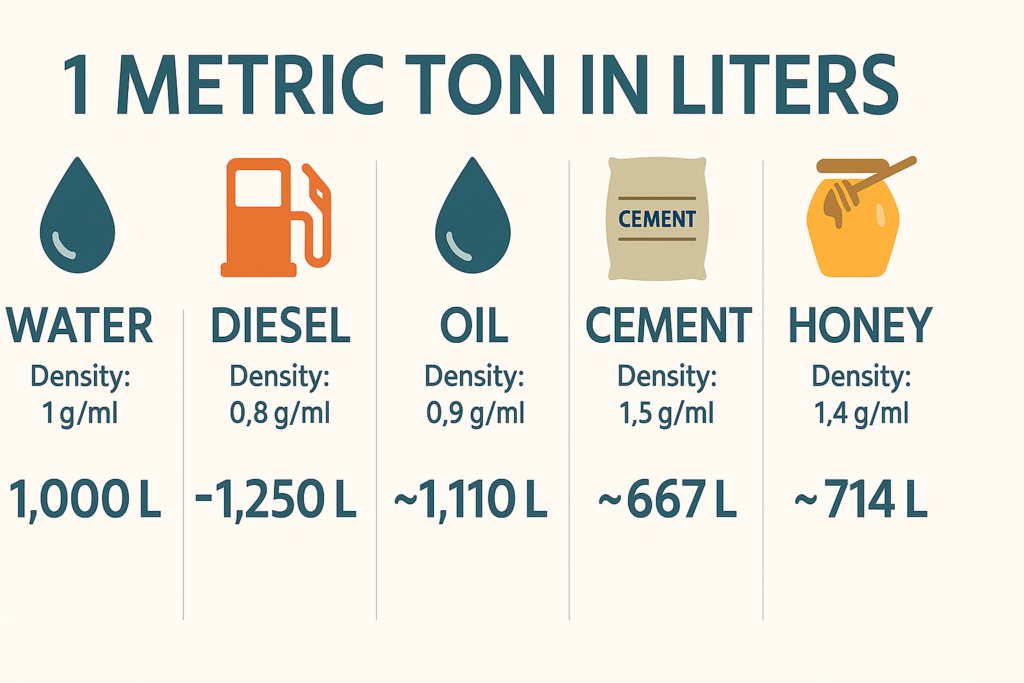When working with liquids or bulk materials in logistics, agriculture, or manufacturing, it’s common to come across the need to convert tons into liters. But there’s no fixed answer unless you know one important factor: the density of the substance.
In this guide, we’ll explore how to convert 1 ton to liters, what role density plays, and provide you with examples and formulas to make accurate conversions for water, oil, cement, fuel, and more.
📏 Understanding the Basics: Ton vs. Liter
Before jumping into conversions, it’s important to understand what each unit measures:
- Ton (Metric Ton or Tonne):
A unit of mass = 1,000 kilograms (kg) = 2,204.62 pounds (lbs) - Liter (L):
A unit of volume = The amount of space a substance occupies
🔄 So, converting from tons to liters means converting from mass to volume, which requires the density of the material.
🧪 What is Density and Why Does it Matter?
Density is defined as:
Density = Mass ÷ Volume
Rearranged for our needs:
Volume (Liters) = Mass (kg) ÷ Density (kg/L)
So to convert 1 ton (1,000 kg) into liters, you need to divide 1,000 kg by the density of the material.

Convert Tons to Kilograms, Grams & Metric Tons
📊 Common Conversions of 1 Ton to Liters (By Material)
| Material | Density (kg/L) | 1 Ton in Liters (approx.) |
| Water | 1.00 | 1,000 L |
| Diesel | 0.832 | 1,201.9 L |
| Petrol (Gasoline) | 0.745 | 1,342.3 L |
| Milk | 1.03 | 970.9 L |
| Cooking Oil | 0.92 | 1,086.9 L |
| Cement (Powder) | 1.44 | 694.4 L |
| Jet Fuel | 0.804 | 1,244 L |
| Honey | 1.42 | 704.2 L |
🔔 Note: These are approximate values. Always use the exact density of the specific substance you’re working with for precise conversions.
🧮 Formula to Convert Ton to Liter
Step-by-step:
- Find the Density of the substance (in kg/L)
- Use the formula:
Liters = 1,000 kg ÷ Density (kg/L)
✅ Example 1: Convert 1 ton of water to liters
- Density of water = 1 kg/L
- Liters = 1,000 ÷ 1 = 1,000 L
✅ Example 2: Convert 1 ton of diesel to liters
- Density of diesel ≈ 0.832 kg/L
- Liters = 1,000 ÷ 0.832 ≈ 1,201.9 L
✅ Example 3: Convert 1 ton of cement to liters
- Density of cement ≈ 1.44 kg/L
- Liters = 1,000 ÷ 1.44 ≈ 694.4 L
🧾 Real-Life Use Cases
- Transport & Shipping:
A fuel tanker may be rated in tons, but needs volume in liters to fill or empty tanks accurately. - Agriculture:
Fertilizers and oils are bought in tons but applied in liters per hectare. - Construction:
Builders often need to convert tons of dry cement into workable volumes. - Food Industry:
Bulk items like milk, oil, or honey are stored by volume but bought in tons.
❗ Important Notes When Converting
- Temperature matters: Density can vary slightly with temperature, especially for liquids like oils and fuels.
- Dry vs. Liquid materials: Converting dry substances (cement, grains, etc.) requires bulk density, which includes air spaces between particles.
- Use accurate density data: Check with product datasheets or industry references for the most accurate density figures.
✅ Quick Reference Table: Convert 1 Ton to Liters
| Substance | Approx. Liters in 1 Ton |
| Water | 1,000 L |
| Diesel | 1,202 L |
| Petrol | 1,342 L |
| Cooking Oil | 1,087 L |
| Jet Fuel | 1,244 L |
| Cement | 694 L |
| Milk | 971 L |
| Honey | 704 L |
📌 FAQ: Converting Ton to Liter
Q: Is 1 ton always 1,000 liters?
A: Only if the substance has a density of 1 kg/L, like water.
Q: How many liters are in a ton of oil?
A: It depends on the oil type, but cooking oil is about 1,087 liters per ton.
Q: How do I find the density of a substance?
A: Check product labels, safety data sheets (SDS), manufacturer specs, or reliable industry references.
🧠 Final Thoughts
Converting 1 ton to liters isn’t a one-size-fits-all formula—it depends on the density of what you’re measuring. Whether you’re managing logistics, farming, or industrial production, understanding how to calculate this correctly ensures you avoid costly mistakes.
With the formula and tables provided here, you can confidently convert tons to liters across multiple materials and applications.

